
How many times do we consider the air quality in our offices or the buildings? How can stale office air affect our health and our productivity in general? We might say that these thoughts don't occur quite often!
The common belief is that we assume the general standards for air quality are already very high. But in reality, they aren't that high at all. Allen (2017), in an HBR article, argues that:
"The amount of ventilation, or fresh outdoor air brought inside, is a critical determinant of health. But does air quality also matter for workers’ productivity and cognitive ability? Research on knowledge workers suggests so. Two studies found that breathing better air led to significantly better decision-making performance among participants. Researchers saw higher test scores across nine cognitive function domains when workers were exposed to increased ventilation rates, lower levels of chemicals, and lower carbon dioxide. Businesses should take action to optimize their air quality for employees’ health and productivity."
Allen (2017) continues by stating that air quality is typically described as stuffy and unpleasant in buildings with low ventilation rates. This not only makes working indoors unpleasant, but the additional pollutants can also create a variety of health problems. Headaches, fatigue, shortness of breath, sinus congestion, cough, sneezing, eye, nose, throat, skin irritation, dizziness, and nausea are all signs of poorly ventilated environments.
This collection of symptoms caused by extended exposure to poorly ventilated spaces has been called the sick building syndrome (SBS). As defined by the World Health Organization in 1984, SBS refers to the nonspecific set of health effects associated with time spent in a particular building.

Photo by Marcus Aurelius from Pexels
With the help of IoT Solutions, poor indoor air quality and the "sick building syndrome" can be a thing of the past. By transforming your old building into a Smart one, you will obtain a centralized, automated control and management system for heating, ventilation, air conditioning, lighting, and other building services. The IoT technology provides an opportunity for every element of the entire Smart Building to enter the space of the Internet and exchange information with other things and systems.
In fact, in the 70s, many buildings tried to reduce the ventilation rates by saving energy. Most of the buildings didn't bring much fresh air inside. Due to this, the phenomenon of "sick building syndrome" with symptoms such as eye irritation, headaches, coughing, and chest tightness started. This situation is still an issue today in many of the residents of these types of buildings, which also occurs due to spending nine or more hours daily in a facility with bad air quality.
Having an unhealthy building damages public health and can be bad for business, severely impacting the productivity of the employees. Not to mention how a "sick building" label would detract from your company or property's appeal. Therefore, every facility manager should be keenly aware of such a hazard and learn ways to prevent it.
So, how can you improve the indoor environmental quality of your building with IoT that will help keep sick building syndrome at bay?

Photo by Mario Gogh on Unsplash
Many studies can prove that a good amount of ventilation, or fresh outdoor air brought inside any building, is a determinant factor for health. After all, good ventilation has been shown to reduce many sick building syndrome symptoms, like absenteeism, and even diminish infectious disease transmission.
Allen et al. (2017) from Harvard School of Public Health explain that:
"Outdoor pollutants can penetrate indoors. Because people spend so much time indoors (90% or more for many people), most of a person’s exposure to outdoor air pollution actually occurs indoors."
Suppose the environment is optimized, meaning that a considerable amount of outdoor air is brought into the space, doubling what is required under the "acceptable indoor air" standard. In that case, you will notice that the employees, while breathing better air, have significantly better decision-making performance, instead of workers exposed to increased ventilation rates, lower levels of chemicals, and lower carbon dioxide. It shows the most significant improvements in areas where they use the information to make strategic decisions and plan, stay prepared, and strategize during crises. After all, it is these crucial decisions that move a company in the right direction.

Photo by Copernico on Unsplash
In addition to the air quality, the temperature also affects workers. Studies show that when an employee works under a standard comfortable temperature and humidity range, they perform better on the tests of decision making, independent of which building they are in.
What should leaders and building managers take away from these studies?
The answer is clear better air quality in any office can facilitate better cognitive performance among your employees. Of course, these are just two studies, but they are wholly consistent with 30 years of science on the benefits of higher ventilation rates.
Facility managers can take some actions to improve the building environment. For example, they can look at the air quality indicators in the building and see where it is possible to improve. However, this is not adequate. While cost may be a concern, it turns out that the cost of improving air quality through higher ventilation rates is far lower than is widely believed. That is where the IoT Solution comes into play and can offer a comprehensive approach to monitoring and measuring several aspects of the buildings' ventilation.

Photo by Proxyclick Visitor Management System from Pexels
In addition to managing ventilation rates, and temperature, managers can consider other critical aspects of the indoor environment that influence health and productivity, such as lighting and noise.
These studies and research add empirical evidence to a long-recognized phenomenon. For example, many of us struggle to concentrate in a conference room that is stuffy and warm, but when a window or door opens and fresh air comes in, it breathes life into the room.
A group of multidisciplinary teams of experts from the Healthy Buildings Program at the Harvard T.H. Chan School of Public Health created "9 Foundations of a Healthy Building", a collection of scientific literature on key topics related to buildings and health. The 9 Foundations curated summaries are designed to be a clear and actionable distillation of the core elements of healthy indoor environments.

Photo credit: Allen et al. (2017). The 9 foundations of a healthy building. Harvard: School of Public Health.
In conclusion, businesses would benefit from recognizing this and optimizing their air quality for employees' health and productivity. Besides, the improvements in the buildings improve health and productivity, increase talent retention and have a higher ROI.